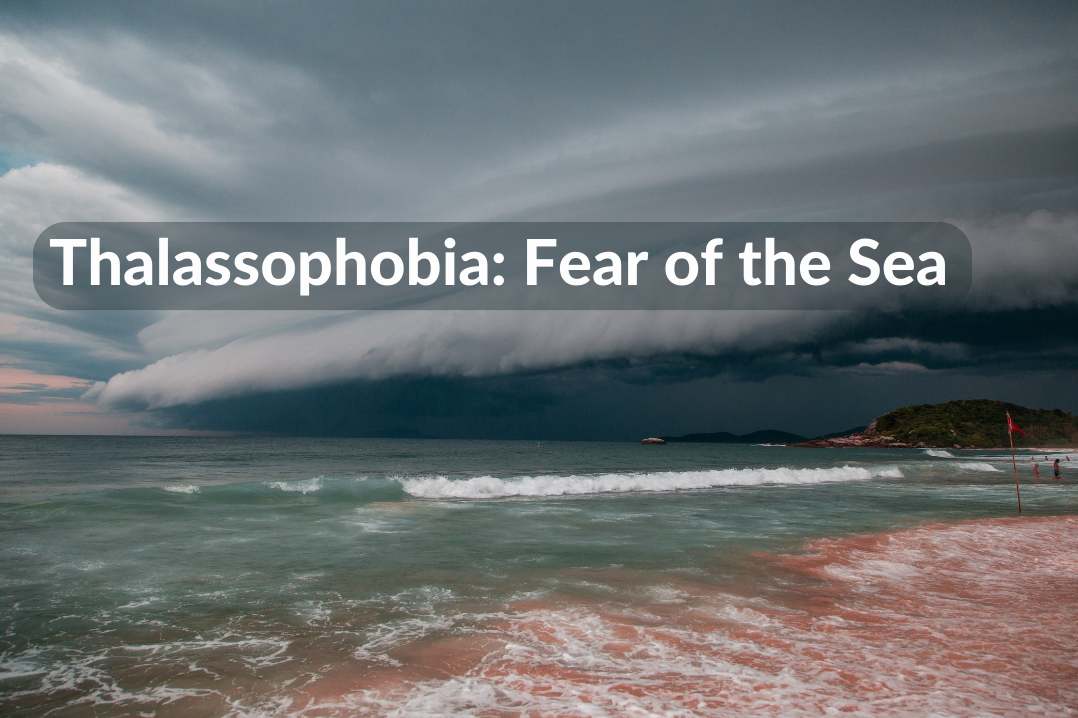
“Fear of the sea is but a tide; with knowledge, it can be calmed.”
Thalassophobia is an irrational and profound fear of the sea, encompassing a dread of not only the ocean but also large lakes, ponds, and rivers. These individuals are intensely fearful of bodies of water with significant depth, perceiving them as potential sources of drowning or inhabited by dangerous creatures, which intensifies their terror.
Individuals afflicted with thalassophobia often make deliberate choices in their daily lives to minimize exposure to large bodies of water, striving to prevent the exacerbation of their phobia. Some may even opt to reside further inland to distance themselves from the sea. While this may offer short-term relief, it can reinforce their belief that the sea is genuinely fearsome, ultimately worsening their condition.
Certain physical limitations, such as poor vision or an inability to swim, may contribute to some people’s fear of the sea. However, those grappling with full-blown thalassophobia experience an exaggerated and disproportionate level of fear. They may even endure panic attacks triggered by the mere thought of the ocean. While real risks exist in oceanic environments, individuals with thalassophobia tend to magnify these risks, making them the central focus of their perception of the sea.
What is Thalassophobia?
Thalassophobia, a term derived from the fusion of two Greek words, “thalasso” signifying ‘sea’ and “phobos” connoting ‘fear,’ is a specific phobia that transcends generational boundaries, affecting individuals of all ages. This unique fear surpasses a simple aversion to water; it encapsulates a far-reaching apprehension deeply rooted in the enigmatic nature of the sea.
The fear associated with thalassophobia isn’t limited to the physical properties of water alone. It encompasses a profound trepidation of the sea’s vastness, a fear that stems from gazing into its seemingly endless expanse. It is a fear of the abyssal depths that remain shrouded in darkness, an uncertainty that stirs unease in the hearts of those afflicted. The sea, with its unpredictable tides and hidden mysteries, becomes an embodiment of anxiety, evoking a primal fear that transcends mere discomfort.
Symptoms of Thalassophobia

Individuals grappling with thalassophobia may manifest a spectrum of distressing symptoms, ranging from the immediate physical manifestations to profound emotional distress. These symptoms can arise not only when directly confronted with the sea but also in response to the mere contemplation of it:
- Panic Attacks: Thalassophobia can induce sudden and overwhelming panic attacks. These episodes are characterized by an abrupt onset of terror, often accompanied by a rapid heart rate that feels like a thunderous drumbeat in the chest. Breathing becomes labored, leading to shortness of breath, as if the very air has been sucked from the surroundings.
- Nausea and Sweating: The physical toll of thalassophobia can be debilitating. Nausea may grip the individual, causing a persistent feeling of queasiness that can escalate to vomiting in severe cases. Profuse sweating often ensues, drenching the individual in cold perspiration. Uncontrollable trembling can further intensify the overall unpleasant experience.
- Avoidance Behavior: Thalassophobia leads individuals to adopt avoidance behavior as a coping mechanism. They may go to great lengths to evade situations involving the sea, be it a seaside vacation, a boat trip, or even swimming in a pool. The fear is so overpowering that it dictates their choices and restricts their participation in water-related activities.
- Emotional Distress: The emotional impact of thalassophobia is profound and enduring. Those afflicted with this phobia bear a constant sense of dread and anxiety, which becomes a relentless companion in their daily lives. This unrelenting fear can permeate their thoughts and actions, undermining their overall quality of life. It can strain relationships, as the fear may interfere with their ability to partake in common activities or engage in family outings centered around water.
- Isolation and Social Withdrawal: In their quest to avoid the sea and its triggers, individuals with thalassophobia may withdraw socially. They may isolate themselves from friends and family, reluctant to reveal the depth of their fear. This isolation can exacerbate feelings of loneliness and contribute to a sense of helplessness.
- Hypervigilance: Thalassophobia can trigger a heightened state of alertness. Sufferers may constantly scan their environment for any signs of water or the sea, even in everyday settings. This hypervigilance can lead to chronic stress and exhaustion.
- Nightmares and Sleep Disturbances: The fear of the sea can infiltrate a person’s dreams, causing recurring nightmares that revolve around water-related scenarios. This leads to sleep disturbances, making it difficult for individuals to obtain restorative sleep.
- Difficulty Concentrating: Thalassophobia can interfere with cognitive function. Individuals may find it challenging to concentrate on tasks or work, as their thoughts continually gravitate toward their fear. This can negatively impact their professional and academic performance.
- Muscle Tension and Body Aches: Chronic anxiety associated with thalassophobia can manifest as muscle tension and body aches. Sufferers may experience soreness, headaches, or even migraines as a physical response to their fear.
- Hypersensitivity to Water-Related Stimuli: Those with thalassophobia may become hypersensitive to stimuli associated with water, such as the sound of waves, the smell of seawater, or the sight of boats. These triggers can evoke a visceral fear response, intensifying their symptoms.
- Depression: Over time, the relentless fear and avoidance behaviors linked to thalassophobia can lead to depression. The inability to enjoy water-related activities or travel to coastal regions can contribute to a persistent sense of sadness and hopelessness.
- Social Impairment: Thalassophobia can impact an individual’s social life. They may decline invitations to social gatherings that involve water-based events, leading to feelings of isolation and disconnection from friends and family.
- Physical Health Complications: Prolonged exposure to chronic stress and anxiety associated with thalassophobia can have adverse effects on physical health. It may contribute to conditions like high blood pressure, heart palpitations, and compromised immune function.
What Causes Thalassophobia?

Understanding the root causes of thalassophobia is crucial for both sufferers and those seeking to support them. While the exact cause may vary from person to person, several common factors contribute to the development of this fear:
- Evolutionary Psychology: One prevailing theory postulates that thalassophobia may have deep-seated evolutionary origins. In our distant past, our ancestors depended on bodies of water for sustenance and survival. However, these aquatic environments also presented considerable threats, such as predators lurking beneath the surface and unpredictable weather conditions. It’s possible that a fear of the sea and large bodies of water was advantageous for survival and may have been inherited as a survival instinct over generations.
- Traumatic Experiences: Traumatic incidents related to water or the sea during childhood or later in life can be powerful triggers for thalassophobia. These experiences might involve close encounters with drowning, witnessing accidents at sea, or being exposed to harrowing narratives about water related disasters. Such traumatic events imprint a lasting fear that associates water with danger.
- Media Influence: The portrayal of the sea as a mysterious and perilous realm in literature, films, and various forms of media can significantly contribute to thalassophobia. These depictions often emphasize the sea’s unpredictability, its association with danger, and the existence of enigmatic creatures beneath the waves. Exposure to these narratives, especially during formative years, can reinforce preexisting fears or plant the seeds of anxiety in susceptible individuals.
Some additional factors that can contribute to the development of thalassophobia:
- Genetic Predisposition: There may be a genetic component to thalassophobia. Some individuals may be more predisposed to developing this fear due to their family history. If close relatives have experienced a fear of the sea, there could be a genetic link that makes certain individuals more susceptible to thalassophobia.
- Early Negative Experiences: Negative encounters with water during early childhood, such as accidental falls into pools or bathtubs, can leave a lasting impression. These early experiences may become etched in the person’s memory, leading to a heightened fear of water and the sea as they grow older.
- Parental Influence: The attitudes and fears of parents or caregivers can play a significant role in the development of thalassophobia. If a child observes their parents displaying fear or anxiety around water, they may internalize these fears and adopt them as their own.
- Lack of Exposure: Limited exposure to water-related activities during childhood can contribute to thalassophobia. If an individual did not have opportunities to learn to swim or engage in water-based play and recreation, they may develop a fear of the unknown associated with large bodies of water.
- Peer Influences: Peer pressure and teasing during adolescence or childhood can also be a factor. Ridicule or teasing related to water-related activities may lead to the development of thalassophobia as individuals strive to avoid situations where they feel vulnerable.
- Underlying Anxiety Disorders: Thalassophobia can sometimes be a manifestation of an underlying anxiety disorder. Generalized anxiety disorder or other specific phobias may coexist with thalassophobia, amplifying the overall fear response.
By recognizing these contributing factors, both individuals affected by thalassophobia and their support networks can better comprehend the origins of this fear and explore strategies for coping and treatment.
Treatment of Thalassophobia

Therapeutic Approaches
Thalassophobia, much like other specific phobias, is amenable to effective treatment. Various therapeutic approaches have been developed to provide individuals with the tools and strategies needed to confront and manage their fear of the sea. Among these approaches, three stand out as particularly promising:
- Cognitive-Behavioral Therapy (CBT): CBT is a widely recognized and empirically supported therapeutic approach that holds considerable promise for individuals dealing with thalassophobia. Within the framework of CBT, individuals work closely with trained therapists to identify and challenge the irrational thoughts and behaviors that are intimately connected to their fear. Through a process of systematic evaluation, individuals learn to reframe their negative thought patterns and replace them with more rational and less fear-inducing beliefs. Additionally, they acquire practical coping strategies to navigate anxiety-provoking situations related to the sea. CBT equips individuals with the skills they need to regain a sense of control over their fear and gradually reduce its impact on their daily lives.
- Exposure Therapy: Exposure therapy is another highly effective therapeutic approach for individuals grappling with thalassophobia. This technique involves gradual and systematic exposure to water-related situations that trigger fear and anxiety. Under the guidance of a trained therapist, individuals confront their phobia in a controlled and supportive environment. The goal is to desensitize them to the fear, allowing them to build resilience and confidence over time. Exposure therapy can be tailored to the individual’s specific fears, starting with less anxiety-provoking scenarios and progressing to more challenging ones as they become more comfortable. Through repeated exposure, individuals often experience a significant reduction in their fear response.
- Medication: In certain cases, particularly when thalassophobia is accompanied by severe anxiety or panic attacks, medication may be considered as a complementary treatment. Anti-anxiety medications, such as selective serotonin reuptake inhibitors (SSRIs) or benzodiazepines, may be prescribed by a qualified healthcare provider. These medications can help alleviate the acute symptoms of anxiety and provide individuals with a sense of relief, making it more manageable for them to engage in therapy and confront their fear. It’s important to note that medication is typically used in conjunction with therapy and not as a standalone treatment.
The availability of these therapeutic approaches offers hope to individuals burdened by thalassophobia. By working closely with trained professionals and committing to the process of treatment, individuals can embark on a journey toward understanding, managing, and ultimately overcoming their fear of the sea. These approaches empower individuals to regain control over their lives and embark on a path towards emotional well-being.
Self-Help Strategies
In addition to professional therapy, individuals with thalassophobia can harness a range of self-help strategies to take an active role in managing their fear of the sea. These empowering approaches can be integral components of the journey toward overcoming thalassophobia:
- Deep Breathing and Relaxation Techniques: Learning to manage anxiety through controlled breathing and relaxation exercises can be immensely beneficial. Deep breathing exercises, also known as diaphragmatic breathing, encourage individuals to take slow, deep breaths, calming their nervous system and reducing the intensity of anxiety. Incorporating these techniques into daily routines or using them during exposure to water-related situations can provide a sense of control and alleviate distress.
- Progressive Muscle Relaxation: Progressive muscle relaxation is another valuable self-help tool. This technique involves systematically tensing and then relaxing different muscle groups in the body. By doing so, individuals can release physical tension associated with anxiety and experience a greater sense of relaxation. Regular practice can enhance the ability to manage fear-inducing situations.
- Visualization and Guided Imagery: Visualization exercises involve mentally creating calming and reassuring images related to water. Individuals can visualize themselves in serene, safe water environments, gradually reducing the intensity of their fear. Guided imagery, often led by audio recordings or guided by a therapist, can provide structured support in developing a positive mental association with water.
- Mindfulness and Meditation: Mindfulness practices cultivate present-moment awareness and can be a valuable resource for managing thalassophobia. By staying grounded in the here and now, individuals can observe their thoughts and emotions without judgment. Mindfulness meditation helps create a mental space in which fear can be acknowledged and addressed with compassion.
- Journaling: Keeping a journal can be a powerful self-help strategy. By recording thoughts, feelings, and experiences related to thalassophobia, individuals can gain insights into their triggers and reactions. Journaling can also serve as a tool for tracking progress and identifying patterns of improvement over time.
- Support Groups and Online Communities (Expanded): Joining a support group or engaging with online communities dedicated to thalassophobia can provide a valuable source of emotional support and practical coping strategies. In these settings, individuals can connect with others who share similar experiences and challenges. Sharing stories, concerns, and triumphs can foster a sense of camaraderie and reduce the sense of isolation often associated with phobias.
- Self-Help Books and Resources: A wealth of self-help books, websites, and mobile applications are available to individuals seeking to confront thalassophobia independently. These resources offer information about the condition, self-guided exercises, and techniques to manage anxiety and fear.
- Exposure Practice at One’s Own Pace: Gradual self-exposure to water-related situations, starting at one’s comfort level, can be a key component of self-help. Individuals can create their exposure hierarchy, beginning with less anxiety-provoking scenarios and progressively challenging themselves as they gain confidence. The self-paced nature of this approach allows for a sense of control and autonomy.
By incorporating these self-help strategies into their daily lives, individuals with thalassophobia can build resilience, enhance their coping skills, and regain a greater sense of agency in their journey towards conquering their fear of the sea. These strategies complement professional therapy and empower individuals to take an active role in their own healing process.
How to Determine if You Have Thalassophobia (Fear of the Sea)
Identifying whether you are experiencing thalassophobia, a specific fear of the sea, involves self-reflection and awareness of your emotional and physical responses to water-related situations. Here are steps to help you assess whether you may have thalassophobia:
- Examine Your Emotional Responses:
- Fear or Anxiety: Reflect on your emotional reactions when you think about or encounter the sea or large bodies of water. Do you experience intense fear, dread, or anxiety in these situations?
- Avoidance Behavior: Consider whether you actively avoid water-related activities or locations like the beach, swimming pools, or lakes due to your fear.
- Discomfort: Think about how you feel when others around you are enjoying water-based activities. If you often feel uncomfortable or distressed in such situations, it may be indicative of thalassophobia.
- Assess Physical Symptoms:
- Panic Attacks: Pay attention to any instances of sudden, intense panic or anxiety attacks when you are near the sea or even just thinking about it. Physical symptoms during these episodes may include a racing heart, shortness of breath, sweating, and trembling.
- Nausea and Sweating: Take note of whether you experience physical symptoms like nausea, sweating, or muscle tension when exposed to water-related scenarios.
- Reflect on Avoidance Behavior:
- Avoidance of Water: Consider whether you consciously avoid water-related activities or locations, even if it means missing out on enjoyable experiences. Frequent avoidance can be a sign of thalassophobia.
- Track Your Thoughts and Beliefs:
- Irrational Thoughts: Are your thoughts about the sea often irrational, such as imagining worst-case scenarios or believing that something terrible will happen in or near the water?
- Seek Self-Help Resources:
- Explore self-help resources, books, and articles about thalassophobia. If you find that the descriptions and experiences shared by others resonate with your own feelings and behaviors, it could be an indicator that you are dealing with thalassophobia.
- Consult a Mental Health Professional:
- If you are unsure about your fear and believe it is significantly impacting your life, it is advisable to seek the guidance of a qualified mental health professional. They can provide a formal assessment and diagnosis, as well as recommend appropriate treatment options.
Remember that recognizing and acknowledging your fear is an essential first step towards addressing thalassophobia. With support and treatment, individuals can learn to manage their fear and regain a sense of control over their lives, allowing them to enjoy water-related activities without overwhelming anxiety.
Conclusion
In this article, we’ve explored the intricacies of thalassophobia, shedding light on its causes, symptoms, and potential treatment avenues. Armed with this knowledge, you can take proactive steps to overcome this fear and lead a life less constrained by irrational anxiety. Remember, you’re not alone, and there is hope for a brighter, water-filled future.
Reference
FAQs
What Exactly Is Thalassophobia?
Thalassophobia is an intense and irrational fear of the sea or large bodies of water. It goes beyond a simple dislike for water; it involves a profound dread of the vastness, darkness, and uncertainty associated with the ocean or other expansive bodies of water.
What Are the Common Symptoms of Thalassophobia?
Thalassophobia can manifest through various symptoms, including panic attacks, nausea, sweating, avoidance behavior, and persistent anxiety. These symptoms often occur when individuals are confronted with situations involving the sea or even just thinking about it.
What Causes Thalassophobia?
The exact cause of thalassophobia can vary from person to person. It may be rooted in evolutionary psychology, traumatic experiences with water, or exposure to media portrayals of the sea as dangerous. Understanding the cause is essential for effective treatment.
Is Thalassophobia Treatable?
Yes, thalassophobia is treatable. Therapeutic approaches like Cognitive-Behavioral Therapy (CBT), exposure therapy, and medication can be effective in helping individuals manage their fear. Additionally, self-help strategies, support groups, and gradual exposure to water-related situations can aid in overcoming thalassophobia.
Can Thalassophobia Affect Daily Life?
Yes, thalassophobia can significantly impact an individual’s daily life. Those who suffer from this fear may avoid beach vacations, water-related activities, and even places with large bodies of water. Over time, this avoidance behavior can restrict opportunities and lead to emotional distress.
